
Table of Contents
Advertisement
Quick Links
Operation & Maintenance
Manual
WARNING
Unsafe use of this machine may cause serious injury
or death. Operators and maintenance personnel
must read this manual before operating or maintain-
ing this machine.
This manual should be kept inside the cab for refer-
ence and periodically reviewed by all personnel who
will come into contact with the machine.
PC12R
PC12R
PC15R
PC15R
HYDRAULIC EXCAVATOR
SERIAL NUMBER
PC12R
- F31493
-8
PC12R
- F31493
-8 HS
PC15R
- F22262
-8
PC15R
- F22262
-8 HS
WEAM002702
-8
-8 HS
-8
-8 HS
and up
and up
and up
and up
Advertisement
Table of Contents













Need help?
Do you have a question about the PC12R-8 and is the answer not in the manual?
Questions and answers